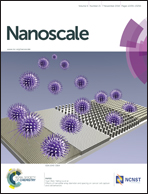Indirect growth of mesoporous Bi@C core–shell nanowires for enhanced lithium-ion storage†
Abstract
In this paper, we propose a facile synthetic strategy for uniform bismuth@carbon (Bi@C) core–shell nanowires, which are prepared via controlled pyrolysis of Bi2S3@glucose-derived carbon-rich polysaccharide (GCP) nanowires under an inert atmosphere. Carbonization of GCP and pyrolysis of Bi2S3 into Bi occur at 500 °C and 600 °C, respectively, which increase the specific surface area and the pore volume of the nanowires, thus allowing accommodation of more lithium ions. Meanwhile, the carbon shell serves as a buffer layer to relieve large volume expansion–contraction during the electrochemical alloy formation, and can also efficiently reduce the aggregation of the nanowires. As a proof-of-concept, the Bi@C core–shell nanowire anodes manifest enhanced cycling stability (408 mA h g−1 after 100 cycles at a current density of 100 mA g−1) and rate capacity (240 mA h g−1 at a current density of 1 A g−1), much higher than pure bismuth microparticles and corresponding Bi2S3@C nanowires.


 Please wait while we load your content...
Please wait while we load your content...